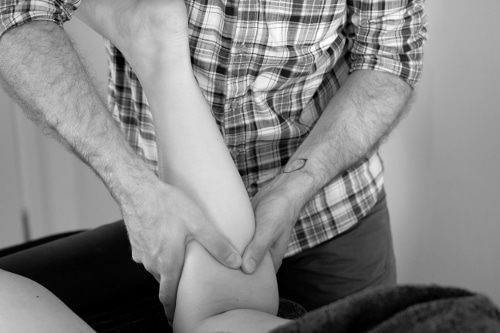What makes it a Sports Massage?
Sitting down to write this piece has opened up a rabbit’s hole, nay an entire warren, of topics surrounding massage therapy, its history and potentially its future – of which I am very lucky to be a part. But I shall save those details for another day, because I intend to keep this fairly brief for the time-pressed readers among you.
Where massage, or a form of therapeutic touch, originated from is difficult to pin down and is likely to be as old as humanity itself. Our instinct to rub a sore spot could conceivably have led to offering to treat others’ hard-to-reach places (such as the back – a favourite treatment area for many clients!) and there are references aplenty demonstrating the practice of massage in the ancient cultures of China, Egypt, India, Greece, and so on.
Indeed it seems that massage has waxed and waned as an orthodox, mainstream treatment for peoples aches and pains over the centuries but it was the introduction of Swedish Massage in a gymnastics setting (accredited in the 1800’s to Per Henrik Ling and developed further by Johan Georg Mezger) that appears to have set the foundation for remedial massage in the West. After scandals caused by the sex industry, the Society of Trained Masseuses was formed in 1894 in the UK, developing over time and in 1944 becoming The Chartered Society of Physiotherapy, as it stands to this day.
However, as the new profession of Physiotherapy looked to broaden its scope of practice (developing some great new approaches along the way) the focus on massage was reduced until it disappeared almost entirely from undergraduate physiotherapy training. My wife is a physiotherapist and was taught massage skills for only a few days within a 3-year degree. In contrast, my qualification followed a full year focussed purely on massage techniques and their role in injury rehab.
It was then in the 1980’s, during the first running boom, that industry leaders such as Mel Cash (Founder and Director of the London School of Sports Massage (LSSM) and the Institute of Sports and Remedial Massage (ISRM), of which I am a member) started to explore the application of massage to a sporting context, with the benefits quickly becoming obvious to therapists and athletes alike. The blending of ‘traditional’ massage techniques with advanced methods used by Osteopaths led to the development of the highest level of massage qualification – ‘Soft Tissue Therapy’, whose practitioners are experts in assessing, treating and rehabilitating a range of minor and chronic injuries and painful conditions.
So how does this circle back to Sports Massage? Well, fundamentally ‘Massage’ is… massage, and ‘Sports Massage’ is massage given in a sporting context – be that pre- or post-competition or training, or performed on an athlete/sports person. However, it is commonly misconstrued as ‘like massage but harder’, and almost by inference, ‘painful’! Yet – It doesn’t have to hurt, and thanks to advances in research we can extrapolate with some confidence as to why…
Scientific research into the efficacy of massage is, frankly, pretty poor. When comparing the quality of the research available to us, if massage was a pill sold by a pharmaceutical company then you’d seriously question any doctor willing to prescribe it! However, we can make cautious assumptions about what is occurring in the body when it is receiving massage based on our understanding of the neural responses to touch (1)(2) helping us to dispel myths and/or question unsupported claims about ‘energy flows’, ‘releasing’ sticky layers of tissue, ‘affecting blood circulation’ (3) and so on. We are now far more comfortable with the notion that the majority of the effects of massage impact on the recipients’ nervous system, notably the autonomic system, which may explain the marked improvements clients can experience in their mood (specifically depression and anxiety) (4), range of movement, pain perception, and overall well-being. We know that in and of itself, massage is seldom a cure for someone’s ills, but based on the evidence available, we understand that it can form an important part of a client’s journey to enhanced movement, reduced pain (5), and ultimately greater fulfilment in life. When properly paired with informed assessment and evidence-based rehabilitation advice, massage can provide a window of opportunity for clients to take responsibility for their own health improvements – be they an elite athlete, or someone wanting to enjoy playing with their grandchildren
- Massage-StLouis.com [Internet]. Sanvito A. How Does Massage Work?; 2016 December 31 [cited 3rd December 2019]]
- Loken LS, Wessberg J, Morrison I, McGlone F, Olausson H. Coding of pleasant touch by unmyelinated afferents in humans. Nature Neuroscience. 2009 May;12(5):547–548.
- Shoemaker JK, Tidus PM, Mader R. Failure of manual massage to alter limb blood flow: Measures by Doppler ultrasound. Medicine & Science in Sports & Exercise. 1997;1:610–14
- Moyer CA. Affective massage therapy. Int J Ther Massage Bodywork. 2008;1(2):3–5.
- Jane SW, Chen SL, Wilkie DJ, Lin YC, Foreman SW, Beaton RD, Fan JY, Lu MY, Wang YY, Lin YH, Liao MN. Effects of massage on pain, mood status, relaxation, and sleep in Taiwanese patients with metastatic bone pain: A randomized clinical trial. Pain. 2011 Oct;152(10):2432–42.

